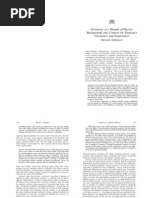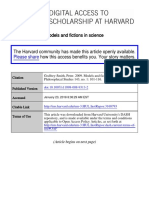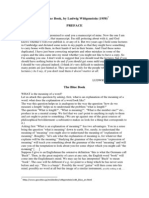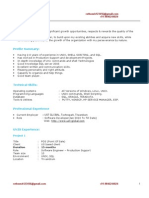Truth and Provability
Truth and Provability
Uploaded by
Trefoilia KnotCopyright:
Available Formats
Truth and Provability
Truth and Provability
Uploaded by
Trefoilia KnotCopyright
Available Formats
Share this document
Did you find this document useful?
Is this content inappropriate?
Copyright:
Available Formats
Truth and Provability
Truth and Provability
Uploaded by
Trefoilia KnotCopyright:
Available Formats
Truth and Provability
RAYMOND M. SMULLYAN
s is well known, in the rst quarter of the twentieth century, there were two mathematical systems, Principia Mathematica, and Zermelo-Fraenkel Set Theory, which were so powerful that it was generally assumed that all mathematical questions could be decided that is, either proved or disprovedin each of the systems. del startled the However, in 1933, the logician Kurt Go mathematical world by proving that this was not the case that in each of these systems, as well as in a variety of related systems, there must be sentences that, though true, could not be proved within the systems. This celebrated result is dels Incompleteness Theorem (more speciknown as Go dels First Incompleteness Theorem). Closely cally as Go related to this result is a theorem of the logician Alfred Tarski, roughly to the effect that in these systems truth of sentences of the system is not denable in the system. Tarskis theorem dels theorem, which in many ways is provides a proof of Go dels original proof. simpler than Go The purpose of this article is to provide the general reader, even those readers with no familiarity with the symbolism of mathematical logic, with the essential ideas behind the proofs del and Tarski theorems. We do this by constructof the Go ing a very simple system (an abstraction of part of Reference [1]), which, despite its simplicity, has enough power for the del arguments to go through. First we address Tarski and Go dels. Finally I present some Tarskis theorem, and then Go related results of my own. All proofs are presented as problems to be solved by the reader. Solutions are provided at the end of the article.
that X belongs to the set named by H, and we accordingly dene the sentence to be true if X really does belong to the set named by H. We call two sentences equivalent if they are either both true or both false (not true). In what follows, it is to be understood that for any predicate H, there is no expression X such that HX is a predicate. Two symbols N and R play a special role, according to the following two rules: RULE RFor any predicate H, the expression RH is also a predicate, and for any predicate K, the sentence RHK is equivalent to HKK. (I use the letter R to suggest the word repeat, because the expression XX is known as the repeat of X.) RULE NFor any predicate H, the expression NH is also a predicate, and for any sentence X, the sentence NHX is true if and only if HX is not true. (I use the letter N to suggest the word not.) From just these two rules follows something surprising. (At least I hope you will be surprised!)
T H E O R E M T (after Tarski). The set of true sentences is
not nameable. It will be helpful in the proof of theorem T to rst prove another result, which is of considerable interest in its own right. A xed point of a predicate H means a sentence X such that X is equivalent to HX. (Fixed points are closely related to self-reference. A xed point X of a predicate H can be thought of as a sentence that asserts its own membership in the set named by Hand this indeed is true if and only if it does belong to the set named by H.) From just Rule R alone follows:
R E T A R S K I . We consider a collection of elements called
symbols, and expression means any nite sequence of these symbols. For any expressions X and Y, by XY is meant the expression X followed by the expression Yfor example, if X is the expression ad and Y is the expression mgr, then XY is the expression admgr. Certain expressions are called predicates, and each predicate is the name of a set of expressions. A set of expressions is called nameable if some predicate names it. By a sentence, we shall mean any expression of the form HX, where H is a predicate and X is any expression whatsoever. We interpret the sentence to mean
T H E O R E M F (Fixed Point Theorem). Every predicate has
a xed point.
P R O B L E M 1. Prove Theorem F by displaying a xed point
of H, using just the symbols H and R. Now let as see how this is related to Theorem T. We will call a predicate H a truth predicate if it names the set of all true sentences. We are to show that no predicate is a truth
2012 Springer Science+Business Media, LLC DOI 10.1007/s00283-012-9328-6
predicate. If H is a truth predicate, then for every sentence X, the sentence HX is true if and only if X is true, which means that every sentence X is a xed point of H! Thus, to show that H is not a truth predicate, it sufces to show that there is at least one sentence that is not a xed point of H. Such a sentence might aptly be called a witness that H is not a truth predicate. Such a witness can in fact be explicitly displayed using the symbols H, N, and R.
P R O B L E M 2. Prove Theorem T by displaying such a witness, using those three symbols.
Note: All the results of this and the next section have applications to standard mathematical systems of the type del, such as Peano Arithmetic investigated by Tarski and Go or Zermelo-Fraenkel set theory. In Peano Arithmetic, what I have called predicates are formulas with one free variable. They are to be thought of as names, not of sets of expressions, but of sets of natural numbers. To each such predicate H, and each natural number n, a sentence is assigned that I will denote as H(n), which is interpreted to mean that n belongs to the set named by H. Actually, the sentence H(n) is the result of substituting the name of n for all free occurrences of the free variable of H. In this system, each expression X is assigned a natural del number of X. The previous number now called the Go results all hold for Peano Arithmetic if, for any predicate H and expression X, we interpret HX to be H(x), where x is the del number of X. As for Rule N, instead of the symbol N, Go which we took for the negation symbol, is the usual symbol *. For any sentence X, the sentence *X of Peano Arithmetic is indeed true if and only if X is not true, and thus Rule N holds. As for Rule R, the symbol R is not one of the symbols of Peano Arithmetic, but for any formula H there is a formula that I have dubbed RH, such that Rule R holds in the del devised an extremely ingenious following sense: Go argument, now known as the diagonal argument, which
rst involved proving the following: For any predicate K with del number k, the sentence K(k) (sometimes called the Go del number, which I will diagonalization of K) has a Go del cleverly showed that for any predicate H, denote as k*. Go there was a predicate H0 (which I denoted RH) such that for del number k, the sentence H0 (k) is any predicate K, with Go equivalent to H(k*), which in the language of this article is that for any predicate H and any predicate K, the sentence RHK is equivalent to HKK, which is Rule R. dels clever diagonal argument is I might remark that Go closely related to, and may well have been inspired by, Cantors famous diagonal argument proving that for any set S, its power set has higher cardinality. Because Rules N and R hold for Peano Arithmetic, so does Tarskis theorem, which for Peano Arithmetic says that there is no predicate H such that for all natural numbers n, the del number of sentence H(n) is true if and only if n is the Go a true sentence.
D E L . We now consider a mathematical sysENTER GO
tem that proves various sentences of the previous section. The system is wholly accurate in the sense that all provable sentences are true, as previously denedthat is, If HX is provable, then X really does belong to the set named by the predicate H, and if NHX is provable, then X does not belong to the set named by H. Unlike the set of true sentences, which we have seen is not nameable, the set of provable sentences IS nameableits name is the symbol P. Therefore, the set of provable sentences and the set of true sentences do not coincide, and because every provable sentence is true, there must be a true sentence X that is not provable in the system. Since its negation NX is not true, then NX is also not provable in the system, and so we have: del). There is a sentence X that is TH E O R E M G (after Go undecidable in the system.
.........................................................................................................................................................
AUTHOR
RAYMOND M. SMULLYAN has lived four different livesas a mathematician, musician, magician, and author
of essays and puzzle books. Born in 1919 in Far Rockaway, New York, he was equally interested in music and science as a child. In high school, he fell in love with mathematics, and he was torn between becoming a mathematician or a concert pianist. He began teaching piano at Roosevelt College in Chicago, but tendonitis in his right arm forced him off the concert stage. He then turned his attention to mathematics, learning mostly on his own, but also taking a few advanced courses at the University of Chicago while supporting himself as a professional magician. Strangely, before he had a college degree, or even a high school diploma, he received an appointment as a mathematics instructor at Dartmouth College on the basis of some papers he had written on mathematical logic. After his time at Dartmouth, the University of Chicago awarded him a Bachelor of Arts degree, based partly on courses he had never taken but had successfully taught. He received his Ph.D. in mathematics from Princeton University in 1959, and subsequently taught at Princeton, New York University, Graduate School, Lehman College, and Graduate Center, and, last, as a distinguished professor at Indiana University. He has published more than 40 research papers on mathematical logic and 26 books on various subjects, six of them on mathematical logic. Two more books will be published this year. Indiana University Bloomington, IN 47405 United States e-mail: rsmullyan@verizon.net
THE MATHEMATICAL INTELLIGENCER
Moreover one can explicitly display such a true but not provable sentence, using the symbols P, N, and R.
P R O B L E M 3. Display such a sentence.
Note: The symbol P that I used does not occur in Peano del created a predicate Bew (known Arithmetic. Instead, Go as the provability predicate, and derived from the German word Beweis = proof), such that for any number n, the del number of sentence Bew(n) is true if and only if n is the Go a provable sentence. D O U B L I N G U P . The following are side issues, but I hope these are not without interest.
P R O B L E M 4. We have seen that a xed point of NH is RNHRNH. There is another one, also, of length 6. Can you nd it?
The following is a useful variant of Theorem F:
T H E O R E M F1 For any predicate H and any predicate K,
there is a sentence X that is equivalent to HKX.
P R O B L E M 5. Prove Theorem F1.
Next is my Double Fixed Point Theorem:
T H E O R E M FF. For any predicates H and K, there are sentences X and Y such that X is equivalent to HY, and Y is equivalent to KX. P R O B L E M 6. Prove Theorem FF.
Now let us go back to our construction of a sentence that is true but is not provable in the system.
P R O B L E M 7. Using the same three symbols, P,N,R, it is
possible to construct two sentences X and Y such that one of the two is true but is not provable in the system, but there is no way to tell which one it is! (Hint: Construct them such that X is true if and only if Y is provable, and Y is true if and only if X is not provable.) There are in fact two solutions in which neither X nor Y are of length more than 8. Can you nd them? I must tell you an amusing incident: The previous problem, together with proofs I have presented in one of my puzzle books, that either Tweedledee exists or Tweedledum exists, but there is no way to tell which led the logician Professor Melvin Fitting, a former student of mine, to introduce me at a lecture I presented once by saying: I now introduce Professor Raymond Smullyan, who will prove to you that either he doesnt exist, or that you dont exist; but you wont know which!
K, we see that RHRH is equivalent to HRHRH. Thus RHRH is a xed point of H. 2. In all that follows, it will be convenient to use the abbreviation iff for if and only if.1 Now, no xed point of NH can possibly be a xed point of H, because for any expression X, NHX is obviously not equivalent to HX. As seen in the solution of Problem 1, for any predicate H, the sentence RHRH is a xed point of H. Because NH is also a predicate, it follows that RNHRNH is a xed point of NH, and is thus not a xed point of H, hence is a witness that H is not a truth predicate. 3. Any xed point X of NP is such a sentence, because X is then true iff NPX is true, iff PX is not true, iff X is not provable. Thus X is true iff X is not provable, which means that either X is true and not provable, or is not true but provable. The latter alternative cannot hold, because it is given that all provable sentences are true. Thus X is true but not provable in the system. We know from Problem 2, taking P for H, that RNPRNP is a xed point of NP, hence it is true but not provable. (Incidentally, another solution is NRPNRP, as you can verify.) 4. A xed point of NH, other than RNHRNH, is NRHNRH, which can be seen as follows: To begin, it is obvious that if X and Y are equivalent sentences, then so are their negations NX and NY. Now, for any predicate H and any predicate Y, the sentence RHY is equivalent to HYY, and so we take NRH for Y, and we see that the sentences RHNRH and HNRHNRH are equivalent, hence so are their negations NRHNRH and NHNRHNRH. Thus NRHNRH is a xed point of NH. 5. RHKRH is equivalent to HKRHKRH, so X is equivalent to HKX, for X the sentence RHKRH. 6. One solution is to use Problem 5: RHKRH is equivalent to HKRHKRH. We take X to be RHKRH and Y to be KRHKRH, which is KX. Thus X is equivalent to KY, and Y is not only equivalent to HX, but IS KX! There is also another solution: We have seen that RHKRH is equivalent to HKRHKRH. Interchanging H with K, it is equally true that RKHRK is equivalent to KHRKHRK. We now take Y to be RKHRK and X to be HRKHRK, which is HY. Thus X is equivalent to HY, because X is HY, and Y is equivalent to KX. Let us record these two solutions: 1X = RHKRH, Y = KRHKRH. 2X = HRKHRK, Y = RKHRK. 7. Let us rst note the following: Suppose X and Y are sentences such that: (1) X is true iff Y is provable. (2) Y is true iff X is not provable. Then one of the two sentences, X, Y, must be true but not provable (but there is no way to tell which one it is). Here is why: The sentence Y must be true, because if it were false, then by (2), X would be provable, hence X is then true, and so by
Solutions
1. We know that RHK is equivalent to HKK for any predicate K, and so it is true for the predicate RH, and so, taking RH for
1
This abbreviation is credited to the late mathematician Paul Halmos.
2012 Springer Science+Business Media, LLC
(1), Y would be provable, thus Y would be false and provable, contrary to the given condition that only true sentences are provable. Thus Y must be true. Therefore by (2), X is not provable. Now, X is either true or not true. If X is true, then it is true but not provable. If X is not true, then by (1), Y is not provable, and so Y is then true but not provable. In summary, If X is true, then X is true but not provable. If X is not true, then it is Y that is true but not provable. There is no way to tell which case holds. We thus seek sentences X and Y such that X is equivalent to PY, and Y is equivalent to NPX. We use the double xed
point theoremin the two solutions (Problem 6) we take P for H and NP for K, and we have: 1X = RPNPRNP, Y = NPRPNPRNP (= NPX). 2X = PRNPPRNP (= PY), Y = RNPPRNP.
REFERENCE
[1] Raymond Smullyan, The Lady or the Tiger, Chapter 15, Alfred A. Knopf, New York, 1982. del incompleteness [2] George Boolos, A new proof of the Go theorem, Notices of the A.M.S. 36 (1989), no. 4, 388390.
THE MATHEMATICAL INTELLIGENCER
You might also like
- Fiber Optic Communications Technology by Djafar K Mynbaev Lowell L Scheiner 0139620699Document5 pagesFiber Optic Communications Technology by Djafar K Mynbaev Lowell L Scheiner 0139620699Satkar AgrawalNo ratings yet
- Perception and Its Objects StrawsonDocument9 pagesPerception and Its Objects StrawsonMilica VuloVicNo ratings yet
- Friedman, Michael - Geometry As A Branch of Physics. Background and Context For Eisnstein's 'Geometry and Experience'Document19 pagesFriedman, Michael - Geometry As A Branch of Physics. Background and Context For Eisnstein's 'Geometry and Experience'John Joseph DorschNo ratings yet
- Ph.D. Comprehensive Exam Information and Reading List: Dept. of Philosophy Marquette UniversityDocument13 pagesPh.D. Comprehensive Exam Information and Reading List: Dept. of Philosophy Marquette UniversityAyazz KhowajaNo ratings yet
- Notes: Chapter I: Descriptions of Maximally Comprehensive PerspectivesDocument21 pagesNotes: Chapter I: Descriptions of Maximally Comprehensive PerspectivesPaulo VidalNo ratings yet
- Lab5 Zybo XilinxDocument10 pagesLab5 Zybo XilinxTryphon Tso-hunterNo ratings yet
- Foundations For A Metaphysics of Pure Process - Is Consciousness PhysicalDocument26 pagesFoundations For A Metaphysics of Pure Process - Is Consciousness PhysicalwakawakwakaNo ratings yet
- On The Semantics of Ought To DoDocument20 pagesOn The Semantics of Ought To DoGustavo VilarNo ratings yet
- Bas Van FraassenDocument10 pagesBas Van FraassenvirtujulioNo ratings yet
- Descartes, Kant and Self Consciousness (Priest, 1981) PDFDocument5 pagesDescartes, Kant and Self Consciousness (Priest, 1981) PDFUjueticaNo ratings yet
- Systematic Ambitions ("The Synoptic Vision") - Davidson and Lewis Ended Up BeingDocument8 pagesSystematic Ambitions ("The Synoptic Vision") - Davidson and Lewis Ended Up BeingMilan MarkovicNo ratings yet
- Hegel's Absolute Idealism and His Dialectical Process of UnderstandingDocument2 pagesHegel's Absolute Idealism and His Dialectical Process of UnderstandingZaky AyatillahNo ratings yet
- Frege - On Sense and NominatumDocument19 pagesFrege - On Sense and NominatumChrista Angela MananquilNo ratings yet
- AA VV - Cognitive Models in Palaeolithic Archaeology - Oxford University Press (2017)Document19 pagesAA VV - Cognitive Models in Palaeolithic Archaeology - Oxford University Press (2017)nlf2205No ratings yet
- Bertalanffy Ensaio Sobre A Relatividade Das CategoriasDocument22 pagesBertalanffy Ensaio Sobre A Relatividade Das CategoriasfabiophiloNo ratings yet
- "I That Is We, We That Is I." Perspectives On Contemporary HegelDocument31 pages"I That Is We, We That Is I." Perspectives On Contemporary HegelgrandebizinNo ratings yet
- Frege's Unquestioned Starting Point: Logic As Science: Jan - Harald.alnes@uit - NoDocument32 pagesFrege's Unquestioned Starting Point: Logic As Science: Jan - Harald.alnes@uit - NoCiaxNo ratings yet
- (Synthese Library 228) Józef M. Bocheński (Auth.), Jan Woleński (Eds.) - Philosophical Logic in Poland-Springer Netherlands (1994)Document362 pages(Synthese Library 228) Józef M. Bocheński (Auth.), Jan Woleński (Eds.) - Philosophical Logic in Poland-Springer Netherlands (1994)Carlos Eduardo Correa RoqueNo ratings yet
- The Zero Dimension Quantum Universe and Zero-Infinity EquivalenceDocument2 pagesThe Zero Dimension Quantum Universe and Zero-Infinity EquivalencePeter DidomenicaNo ratings yet
- Irad Kimhi - Thinking and Being (2018)Document174 pagesIrad Kimhi - Thinking and Being (2018)lazarNo ratings yet
- The First Person (Anscombe) PDFDocument9 pagesThe First Person (Anscombe) PDFGHajNo ratings yet
- Journal of Philosophy, IncDocument20 pagesJournal of Philosophy, Incalvaro_arroyo17No ratings yet
- Heidegger Age World PictureDocument27 pagesHeidegger Age World PictureBarry Frydlender50% (2)
- Raffoul The Aporia of HistoryDocument34 pagesRaffoul The Aporia of HistoryFrancois RaffoulNo ratings yet
- Language and MindDocument19 pagesLanguage and MinddavidrojasvNo ratings yet
- Kant's Transcendental Deduction of The CategoriesDocument18 pagesKant's Transcendental Deduction of The CategoriesKatie Soto100% (1)
- Victor Frederick Weisskopf 1 9 0 8 - 2 0 0 2: National Academy of SciencesDocument27 pagesVictor Frederick Weisskopf 1 9 0 8 - 2 0 0 2: National Academy of SciencesriskycodeNo ratings yet
- Spinoza - The Three Kinds of KnowledgeDocument2 pagesSpinoza - The Three Kinds of KnowledgeAhmadNo ratings yet
- Lejewski - Ontology, What Next?Document13 pagesLejewski - Ontology, What Next?Philip_Marlowe_314No ratings yet
- Carnap - Old and New LogicDocument7 pagesCarnap - Old and New LogicVanBolhuisNo ratings yet
- ThvedtDocument7 pagesThvedtEpic WinNo ratings yet
- SpaceDocument24 pagesSpaceHurditya KhambraNo ratings yet
- The Theory of Forms and SemiologyDocument4 pagesThe Theory of Forms and SemiologyMeg StraussNo ratings yet
- Two Dimensional Time and The Specious PresentDocument91 pagesTwo Dimensional Time and The Specious PresentRussell ClarkNo ratings yet
- Ethics A Contemporary Introduction 3rd Edition Harry J Gensler 2024 Scribd DownloadDocument65 pagesEthics A Contemporary Introduction 3rd Edition Harry J Gensler 2024 Scribd Downloadazrahdasen9c100% (5)
- Saying and Showing in WittgensteinDocument22 pagesSaying and Showing in WittgensteinFafnerNo ratings yet
- Quine (1956)Document12 pagesQuine (1956)miranda.wania8874No ratings yet
- Perry - Borges y Yo y Yo PDFDocument18 pagesPerry - Borges y Yo y Yo PDFToño JVNo ratings yet
- The Concept of NatureThe Tarner Lectures Delivered in Trinity College, November 1919 by Whitehead, Alfred North, 1861-1947Document97 pagesThe Concept of NatureThe Tarner Lectures Delivered in Trinity College, November 1919 by Whitehead, Alfred North, 1861-1947Gutenberg.orgNo ratings yet
- Defending A Dogma: Between Grice, Strawson and Quine: Elvis ImafidonDocument10 pagesDefending A Dogma: Between Grice, Strawson and Quine: Elvis ImafidonYang Wen-LiNo ratings yet
- Models and Fictions in Science: Please ShareDocument23 pagesModels and Fictions in Science: Please SharevolveramonNo ratings yet
- Russell Versus HegelDocument8 pagesRussell Versus Hegelurlia100% (1)
- Shodhganga Russell PDFDocument36 pagesShodhganga Russell PDFSreeram KN Namboothiri100% (1)
- Model Theory For Modal Logic - Kripke Models For Modal Predicate Calculi (Kenneth A. Bowen) PDFDocument147 pagesModel Theory For Modal Logic - Kripke Models For Modal Predicate Calculi (Kenneth A. Bowen) PDFluis mujicaNo ratings yet
- Ingvar Johansson - Ontological InvestigationsDocument22 pagesIngvar Johansson - Ontological InvestigationsAna CarneiroNo ratings yet
- Realism and Instrumentalism in Pre-Newtonian Astronomy: Michael R. GardnerDocument65 pagesRealism and Instrumentalism in Pre-Newtonian Astronomy: Michael R. GardnerNiranjan Vengallur100% (1)
- TARSKI A., CORCORAN J. - Logic, Semantics, Metamathematics - Papers From 1923 To 1938Document540 pagesTARSKI A., CORCORAN J. - Logic, Semantics, Metamathematics - Papers From 1923 To 1938Mad_Trickster100% (2)
- Kremer - Interpreting Arnauld (1990)Document197 pagesKremer - Interpreting Arnauld (1990)panntelis100% (1)
- AlakkaDocument3 pagesAlakkaGaurav SinghNo ratings yet
- Countless Life. For A Liberation of Thou PDFDocument11 pagesCountless Life. For A Liberation of Thou PDFMilićević SlobodanNo ratings yet
- The Indispensability of Mathematical Truth in The Earliest UniverseDocument12 pagesThe Indispensability of Mathematical Truth in The Earliest UniverseaaronNo ratings yet
- Thomasson - Fictional EntitiesDocument18 pagesThomasson - Fictional EntitiesJuan Pablo FautschNo ratings yet
- J. Bacon, SupervenienceDocument15 pagesJ. Bacon, SuperveniencePaolo ComanducciNo ratings yet
- Robert Merrihew Adams - What Is, and What Is in Itself - A Systematic Ontology-Oxford University Press (2022)Document240 pagesRobert Merrihew Adams - What Is, and What Is in Itself - A Systematic Ontology-Oxford University Press (2022)Thiago Bragantin100% (2)
- Science of PhilosophyDocument18 pagesScience of PhilosophyVincent VerletNo ratings yet
- Quantifiers, Questions and Quantum Physics - Essays On The Philosophy of Jaakko Hintikka - UnlockedDocument358 pagesQuantifiers, Questions and Quantum Physics - Essays On The Philosophy of Jaakko Hintikka - UnlockedAnonymous bb2Xaf100% (1)
- An Introduction To Symbolic Logic: Guram Bezhanishvili and Wesley FussnerDocument24 pagesAn Introduction To Symbolic Logic: Guram Bezhanishvili and Wesley Fussnerジー デイNo ratings yet
- Russells LogicismDocument28 pagesRussells LogicismAnderson Luis NakanoNo ratings yet
- Wittgenstein The BLUE BOOK Excerpt ShortDocument1 pageWittgenstein The BLUE BOOK Excerpt ShortAlba MarínNo ratings yet
- Mary Shepherd PDFDocument56 pagesMary Shepherd PDFMarcela B. Tavares100% (1)
- Q2019-TL-RZ7AEE: Pasig Branch Taguig Branch Cebu Branch Davao BranchDocument1 pageQ2019-TL-RZ7AEE: Pasig Branch Taguig Branch Cebu Branch Davao BranchIzzyMaxinoNo ratings yet
- Girish Chadha - 29th December 2022Document35 pagesGirish Chadha - 29th December 2022Girish Chadha100% (3)
- Cv-Abdul Nasir ZamanDocument2 pagesCv-Abdul Nasir Zamanazhar_iqbal2000No ratings yet
- Work Schedules in SAP HRDocument8 pagesWork Schedules in SAP HRShiva Kiran VaddiparthiNo ratings yet
- Limit & Continuity (New Handout)Document9 pagesLimit & Continuity (New Handout)Siti Khadijah Mohd ZainNo ratings yet
- T9 - MIPS-Tutorial Sheet ODD SEM 20222Document4 pagesT9 - MIPS-Tutorial Sheet ODD SEM 20222RITIK MEHROTRA 20103329No ratings yet
- Computational GeometryDocument5 pagesComputational GeometryZvonko TNo ratings yet
- DBMS Question BankDocument16 pagesDBMS Question BankGangadhar BhuvanNo ratings yet
- The Ascii and Ebcdic TablesDocument4 pagesThe Ascii and Ebcdic TableskiranNo ratings yet
- Social Media Etiquette and Applicable LawsDocument36 pagesSocial Media Etiquette and Applicable LawsLean Jeff MagsombolNo ratings yet
- 1 - CCLA - PoLR Circulars I To VIDocument65 pages1 - CCLA - PoLR Circulars I To VIPlanningsecretary 02No ratings yet
- Functions and Principles of Material HandlingDocument16 pagesFunctions and Principles of Material HandlingSAMNo ratings yet
- GatelinkDocument9 pagesGatelinkapi-14570092No ratings yet
- Difference Between File System and DBMSDocument9 pagesDifference Between File System and DBMSHarshit RajputNo ratings yet
- High-Level Programming LanguageDocument6 pagesHigh-Level Programming LanguageAkshay Jadhav PatilNo ratings yet
- Conceptual Design Optimization of Francis TurbinesDocument11 pagesConceptual Design Optimization of Francis TurbinesJun GWan ParkNo ratings yet
- Career Objective: English, Hindi (Intermediate), Mother Tongue - MalayalamDocument3 pagesCareer Objective: English, Hindi (Intermediate), Mother Tongue - Malayalamamit kumarNo ratings yet
- Unix Production SupportDocument3 pagesUnix Production Supportretheesh123456No ratings yet
- Director Manager IT Infrastructure Operations in Dallas FT Worth TX Resume Jody HesterDocument3 pagesDirector Manager IT Infrastructure Operations in Dallas FT Worth TX Resume Jody HesterJodyHesterNo ratings yet
- Per App SlidesDocument30 pagesPer App SlidesSatya VasuNo ratings yet
- BP Metric 3.2 Total Downtime Olver 050222 FCDocument2 pagesBP Metric 3.2 Total Downtime Olver 050222 FCRicardo Araos DuránNo ratings yet
- montajMagmapFiltering PDFDocument82 pagesmontajMagmapFiltering PDFJoaquin Arturo Matos De Leon100% (2)
- Dotnet Visual Basic Developing Apps Programming Drives Directories FilesDocument96 pagesDotnet Visual Basic Developing Apps Programming Drives Directories FilesPonthepNo ratings yet
- BTP ReportDocument17 pagesBTP ReportSAJAL PATHAKNo ratings yet
- RNC PAT ChecklistDocument41 pagesRNC PAT ChecklistSudipta DasNo ratings yet
- Network Element Management Information Model For The Signalling Connection ControlDocument103 pagesNetwork Element Management Information Model For The Signalling Connection Controlhs_soni2457No ratings yet
- Unit 2Document41 pagesUnit 2goelh6718No ratings yet
- Graphical Method in LPDocument15 pagesGraphical Method in LPPranav AggarwalNo ratings yet

























































































